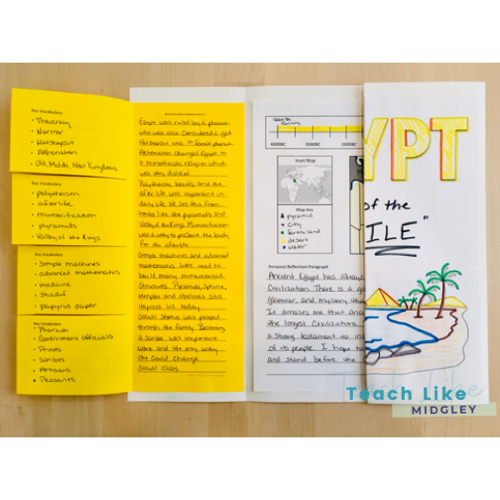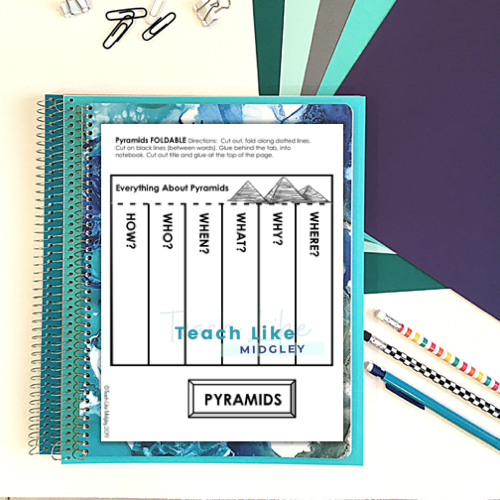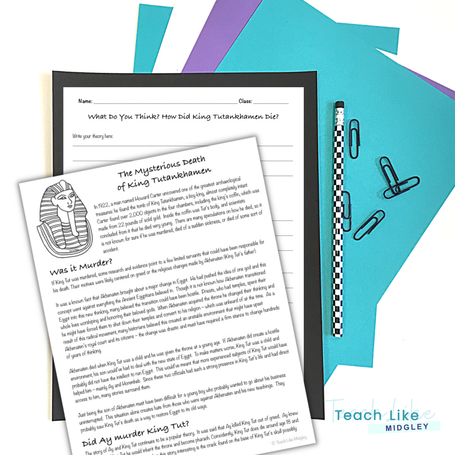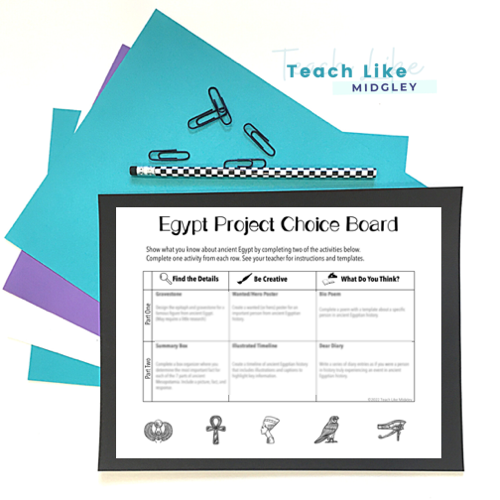5 Low-Prep Student Projects and Activities for your Ancient Egypt Unit
Ancient Egypt is by far one of my favorite units to teach. There are so many exciting topics to cover. From pharaohs, to pyramids, to mummification, mythology, the Valley of the Kings, I could go on and on!
But with as exciting as it can all be, ancient Egypt can also be VERY overwhelming. There are almost too many aspects that you could dive into! How do you choose projects and activities? It’s easy to want to do them all!
Not to mention all the projects you can find when you go search online. Some ancient Egypt activities are really elaborate too!
But with as exciting as it can all be, ancient Egypt can also be VERY overwhelming. There are almost too many aspects that you could dive into! How do you choose projects and activities? It’s easy to want to do them all!
Not to mention all the projects you can find when you go search online. Some ancient Egypt activities are really elaborate too!
Maybe you want to make the best of your instruction time. Maybe you are limited on supplies. Or perhaps you just don’t want to find yourself in the middle of project chaos. Whatever brought you here, let me share with you my favorite ancient Egypt projects and activities that are engaging, purposeful, and low prep.
Activity #1 - KWL Chart
No doubt EVERYONE has at least heard of ancient Egypt. Even your students. Many will come to your class eager to learn more, and perhaps share what they “think” they already know.
I find the best way to manage student excitement and misconceptions, is with a good old fashion KWL chart. A typical KWL chart includes columns for What I Know, What I Want to Know, and What I’ve Learned.
I modify this slightly into two columns: What I Think I Know, and What I Want to Know.
Together as a class, we fill out our chart. The first column gives students a chance to share with me what they think they already know – and it provides excellent insight as to what common misconceptions my students have about ancient Egypt.
The second column offers a chance for students to share what they are most interested in learning about. This can be very valuable when making final decisions about projects we will complete in class and help me to be prepared for questions during our lessons.
I find the best way to manage student excitement and misconceptions, is with a good old fashion KWL chart. A typical KWL chart includes columns for What I Know, What I Want to Know, and What I’ve Learned.
I modify this slightly into two columns: What I Think I Know, and What I Want to Know.
Together as a class, we fill out our chart. The first column gives students a chance to share with me what they think they already know – and it provides excellent insight as to what common misconceptions my students have about ancient Egypt.
The second column offers a chance for students to share what they are most interested in learning about. This can be very valuable when making final decisions about projects we will complete in class and help me to be prepared for questions during our lessons.
Activity #2 - Comprehensive Lap-book
While I believe STEM/STEAM projects are very valuable and help students develop excellent skills, I also believe in the power of comprehensive projects that help students with content.
I have come to really love these lap-book projects for ancient civilizations. Students work together in pairs to gather the information, but then get to put together their very own project. This design has lots of benefits. Including holding each student accountable for material (absences can be a real issue with partner/group projects) but they still have the chance to develop their skills at working cooperatively.
And best of all, every student can find success with these projects. Templates provide the support students need, even though they still allow for some creativity.
These comprehensive projects make for a great culminating activity that can serve as review or even as an assessment.
Activity #3 - Famous Pharaohs
No unit on ancient Egypt is complete without an exploration of some famous pharaohs! This doesn’t have to be fancy and elaborate for students to engage and learn!
I pick 6 pharaohs for students to explore. Arrange the student desks into 6 groups – one per pharaoh. Each group is provided a stack of non-fiction books (my own collection and from the library) that contain information about their pharaoh.
Groups get about 30 minutes to explore the books collectively find specific information about their pharaoh. After this work time, each group shares what they discovered and we post the information on the board for the entire class to copy into their notebooks.
This is a great exercise for students to develop skills in finding information. Some groups will divide up topics to search for, while others just share whatever they find in their books.
#4 - The 5 W's of the Egyptian Pyramids
Before you get caught up in making pyramids out of sugar cubes, be sure you are coving the essential concepts!
An easy way to do this, is to have students focus on the 5 W’s of the Pyramids: Who, What, When, Where, and Why.
The 5 W’s is actually one of my favorite structures for organizing content. If you don’t give students a directional focus, they will end up remembering some obscure fact (which is great!) but then will likely miss the important stuff.
An easy way to do this, is to have students focus on the 5 W’s of the Pyramids: Who, What, When, Where, and Why.
The 5 W’s is actually one of my favorite structures for organizing content. If you don’t give students a directional focus, they will end up remembering some obscure fact (which is great!) but then will likely miss the important stuff.
#5 - The Death of Tutankhamen
Who can resist an engaging activity that involves a mysterious death of a boy king?
Let your students dive into the stories, theories, and the scientific studies. They will eat it up!
Encourage students to develop their own theory of how Tutankhamen died, based on the evidence they find. This is also a great lead in to a persuasive writing piece.
Pro Tip: Save this activity for Halloween. It’s always a challenge to keep students focused and learning the day they all wear their costumes to school. This lesson will do it!
Let your students dive into the stories, theories, and the scientific studies. They will eat it up!
Encourage students to develop their own theory of how Tutankhamen died, based on the evidence they find. This is also a great lead in to a persuasive writing piece.
Pro Tip: Save this activity for Halloween. It’s always a challenge to keep students focused and learning the day they all wear their costumes to school. This lesson will do it!
BONUS - Student Project Choice Boards
Providing student choice is one of your most powerful weapons for increasing student engagement.
But within choice, you must also provide structure to help your students find success. Avoid giving students free reign. While a few will be able to find success, free reign will create a lot of stress on many of your students.
These Student Project Choice Boards have so many great benefits. Not only do students get to choose what interests them, but they also allow students to choose projects that connect to their learnings styles and strengths. And each project has a clear learning outcome.
But within choice, you must also provide structure to help your students find success. Avoid giving students free reign. While a few will be able to find success, free reign will create a lot of stress on many of your students.
These Student Project Choice Boards have so many great benefits. Not only do students get to choose what interests them, but they also allow students to choose projects that connect to their learnings styles and strengths. And each project has a clear learning outcome.
Ready To Roll Materials
Hopefully these ancient Egypt project ideas and low prep activities will help guide you in your unit plans.
Remember, learning can be fun and engaging for students and teachers! And utilizing these effective activities and projects will help you leave the overwhelm behind.
And if you want materials that are already created for you, then you know I’ve got you covered!
Ancient Egypt Lap-book Project
Ancient Egypt: The Mysterious Death of King Tut
Ancient Egypt Student Project Choice Board with Templates
Remember, learning can be fun and engaging for students and teachers! And utilizing these effective activities and projects will help you leave the overwhelm behind.
And if you want materials that are already created for you, then you know I’ve got you covered!
Ancient Egypt Lap-book Project
Ancient Egypt: The Mysterious Death of King Tut
Ancient Egypt Student Project Choice Board with Templates
You May Also Like...
Let's Connect...

Welcome! I'm Hillary Midgley, a veteran 6th grade teacher.
I create educational materials and develop curriculum for other teachers. I specialize in teaching students how to learn through my Study Skills Curriculum. I have established fundamental classroom systems and structures for teachers to help them streamline their classroom. And my passion is teaching ancient history through engaging activities with foundations in academic skills. Here you will find resources on all of these topics and more. Learn more about me here.
|












